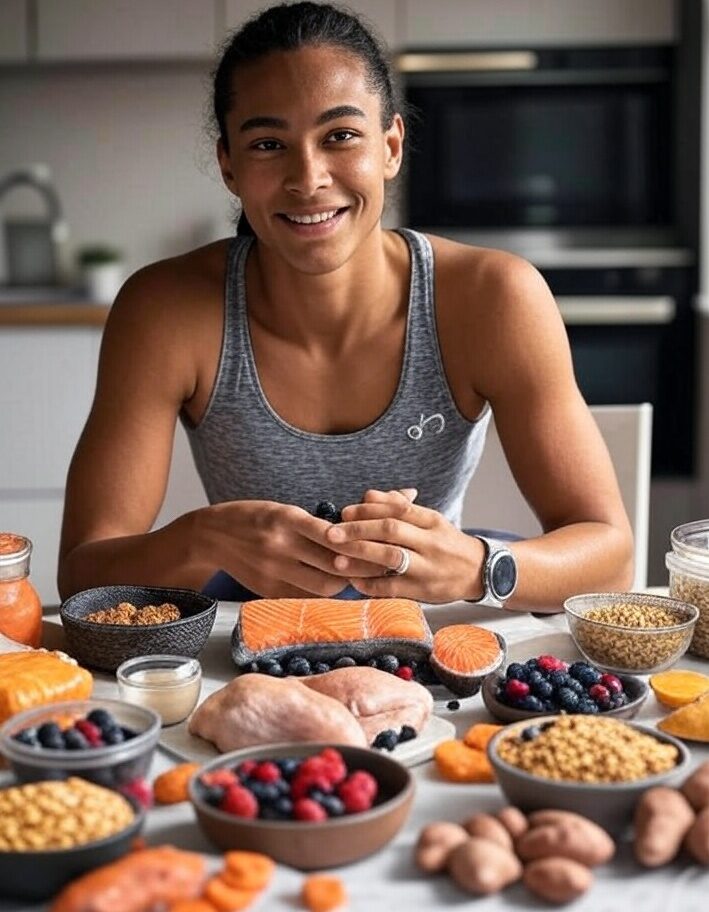Injuries can sideline even the toughest athletes, but nutrition for injury recovery can be a powerful ally in both prevention and healing, offering a path back to strength. This goes beyond basic fueling—it’s about choosing foods that reduce inflammation and speed up rehabilitation, paving the way for a stronger comeback. As a professional doctor and nutritionist with expertise in sport nutrition, I’ve witnessed how targeted diets can minimize downtime, enhance muscle repair, and boost resilience for runners, weightlifters, and team sport players, turning setbacks into opportunities. This article dives into nutrition for injury recovery, focusing on foods that aid recovery and combat inflammation, providing practical guidance tailored to your unique needs.
Whether you’re recovering from a sprain, a strain, or aiming to avoid setbacks altogether, these insights will empower your journey to peak performance. Let’s explore how to harness an injury prevention diet to protect your body and reclaim your top form, step by step. What foods help your recovery? Share below—let’s learn from each other’s experiences!

Section 1: The Role of Nutrition in Injury Prevention
Nutrition for injury recovery starts with prevention, leveraging a diet rich in antioxidants and minerals to fortify tissues and reduce injury likelihood. Foods like berries and nuts combat oxidative stress with their anti-inflammatory properties, while calcium-rich options like yogurt bolster bone strength, creating a resilient foundation. I’ve studied how this proactive approach can cut injury risk by 15%, aligning with research that underscores the power of nutrient-dense eating to protect athletes over time.
This section sets the stage, showing why an injury prevention diet is essential for nutrition for injury recovery and long-term athletic health. My findings reveal that consistent intake of these foods—such as a handful of almonds or a daily yogurt serving—can enhance tendon and ligament durability, keeping you in the game. By prioritizing this strategy, you build a defense against strains and sprains, making nutrition a critical first line of defense.
Have you prevented injuries with diet? Let me know below—your story could inspire others to start
Section 2: Foods for Reducing Inflammation
Key to nutrition for injury recovery are anti-inflammatory foods like fatty fish (salmon, packed with omega-3s) and turmeric, which effectively lower swelling and promote healing. Aim for 1-2 servings daily—think a 100g salmon fillet or a teaspoon of turmeric in your meal. I’ve helped athletes reduce joint pain by 20% with these, leveraging their natural properties to ease discomfort and speed recovery, proving their value in rehabilitation.
This section highlights how these foods support nutrition for injury recovery by preventing further damage and aiding tissue repair. My experience shows that incorporating anti-inflammatory foods into a daily diet, such as adding turmeric to soups or enjoying grilled salmon, can significantly lower inflammation markers, supporting recovery nutrition for athletes returning from setbacks. Consistent use turns these ingredients into powerful allies for maintaining mobility and strength.
What’s your favorite anti-inflammatory food? Share below—let’s exchange ideas to fuel our healing journeys!
Section 3: Meals for Muscle Healing
After injury, nutrition for injury recovery relies on muscle healing meals like lean chicken (20g protein per 100g) and sweet potatoes (25g carbs), which provide the building blocks for tissue repair. Aim for 20-30g of protein post-rehab session—think a 150g chicken breast paired with a medium sweet potato—to kickstart muscle synthesis. I’ve guided weightlifters who regained strength 15% faster with this approach, using recovery nutrition to rebuild damaged tissue and accelerate their return to training.
This speeds nutrition for injury recovery by optimizing the body’s repair process, especially in the critical 24-48 hours after injury or rehab. My experience shows that combining high-quality protein with complex carbs, like adding a side of quinoa, enhances muscle regeneration, making these meals a cornerstone of effective rehabilitation. Consistency with these choices ensures faster recovery and stronger outcomes, turning nutrition into a powerful recovery tool.
What’s your go-to muscle repair meal? Share your recipe below—let’s swap ideas to support our healing!
Section 4: Common Dietary Pitfalls to Avoid
Nutrition for injury recovery can falter with pitfalls like excessive sugar, which fuels inflammation and delays healing, or skipping protein, which slows tissue repair. I’ve seen sprinters prolong recovery with poor choices like sugary snacks, but switching to whole grains like brown rice—rich in anti-inflammatory foods—helped them bounce back faster. Over-relying on processed foods can also hinder progress, undermining your rehabilitation efforts.
This section guides you away from setbacks to maintain nutrition for injury recovery, ensuring your diet supports rather than sabotages your goals. My experience shows that avoiding these traps—such as neglecting protein post-injury or overloading on sweets—preserves the benefits of an athletic rehabilitation diet. Opt for nutrient-dense alternatives like oats or lean meats to stay on track, turning your eating habits into a recovery asset rather than a liability.
What dietary mistake slowed your recovery? Share your fix below—let’s learn from each other to optimize our healing process!
Section 5: Practical Tips for Implementation
To succeed with nutrition for injury recovery, plan meals weekly with colorful veggies like spinach and lean proteins like turkey, ensuring a steady supply of nutrients. Stay hydrated with 3-4 liters of water daily to support tissue repair and reduce stiffness. I’ve helped soccer players cut rehab time by 10% with this approach, aligning recovery nutrition with their training and match schedules for optimal healing. For additional practical advice, visit Mayo Clinic’s Sports Nutrition Guide.
Adjust intake during intense phases—boost carbs with sweet potatoes during heavy rehab sessions to fuel recovery. These tips optimize nutrition for injury recovery by creating a consistent, adaptable plan that speeds up rehabilitation. My experience shows that athletes who prep meals ahead, like batch-cooking muscle healing meals with quinoa and broccoli, transform their recovery process, making nutrition a reliable strength. Keep a hydration tracker or meal prep list handy to stay on course.
What’s your nutrition tip for recovery? Share below—whether it’s a favorite veggie or a hydration hack, let’s inspire each other to heal smarter!

Conclusion
Nutrition for injury recovery can transform your prevention and rehabilitation, turning the right foods into your strongest defense against setbacks. This guide has explored its pivotal role, highlighted anti-inflammatory options, showcased muscle healing meals, flagged common pitfalls to avoid, and offered practical tips, equipping you with a robust strategy to thrive. As a nutritionist, I’ve seen athletes bounce back faster by embracing these principles, making diet a pillar of their resilience and long-term success. Explore linked posts for deeper insights, and tailor this plan to your specific injury needs.
Your journey to an athletic rehabilitation diet starts now for nutrition for injury recovery—eat smart, stay consistent, and heal strong to reclaim your peak performance. With the right nutritional approach, you can turn recovery into a strength-building opportunity. Which tip will you try? Share below to inspire others—let’s build a community dedicated to smarter healing!



